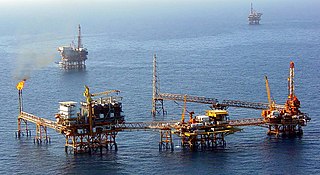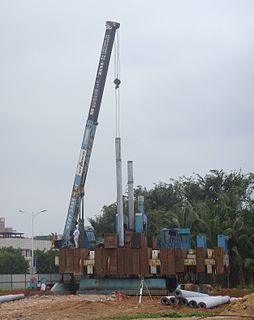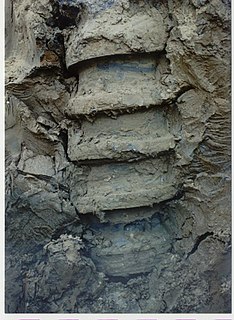Related Research Articles

Geotechnical engineering, also known as geotechnics, is the branch of civil engineering concerned with the engineering behavior of earth materials. It uses the principles and methods of soil mechanics and rock mechanics for the solution of engineering problems and the design of engineering works. It also relies on knowledge of geology, hydrology, geophysics, and other related sciences.

In engineering, a foundation is the element of a structure which connects it to the ground, and transfers loads from the structure to the ground. Foundations are generally considered either shallow or deep. Foundation engineering is the application of soil mechanics and rock mechanics in the design of foundation elements of structures.
In construction or renovation, underpinning is the process of strengthening the foundation of an existing building or other structure. Underpinning may be necessary for a variety of reasons:

In geotechnical engineering, a caisson is a watertight retaining structure used, for example, to work on the foundations of a bridge pier, for the construction of a concrete dam, or for the repair of ships. Caissons are constructed in such a way that the water can be pumped out, keeping the work environment dry. When piers are being built using an open caisson, and it is not practical to reach suitable soil, friction pilings may be driven to form a suitable sub-foundation. These piles are connected by a foundation pad upon which the column pier is erected.

A deep foundation is a type of foundation that transfers building loads to the earth farther down from the surface than a shallow foundation does to a subsurface layer or a range of depths. A pile or piling is a vertical structural element of a deep foundation, driven or drilled deep into the ground at the building site.
Crosshole sonic logging (CSL) is a method to the structural integrity of drilled shafts and other concrete piles.
Dynamic load testing is a method to assess a pile's bearing capacity by applying a dynamic load to the pile head while recording acceleration and strain on the pile head. Dynamic load testing is a high strain dynamic test which can be applied after pile installation for concrete piles. For steel or timber piles, dynamic load testing can be done during installation or after installation.
High strain dynamic testing is a method of testing deep foundations to obtain information about their capacity and integrity, and in some cases, to monitor their installation. It is codified by ASTM D4945-12 - Standard Test Method for High-Strain Dynamic Testing of Piles.
Ground–structure interaction (SSI) consists of the interaction between soil (ground) and a structure built upon it. It is primarily an exchange of mutual stress, whereby the movement of the ground-structure system is influenced by both the type of ground and the type of structure. This is especially applicable to areas of seismic activity. Various combinations of soil and structure can either amplify or diminish movement and subsequent damage. A building on stiff ground rather than deformable ground will tend to suffer greater damage. A second interaction effect, tied to mechanical properties of soil, is the sinking of foundations, worsened by a seismic event. This phenomenon is called soil liquefaction.

Wilfred George Kenneth Fleming was an influential piling engineer and former chairman of the Federation of Piling Contractors.
The Statnamic load test is a type of test for assessing the load-carrying capacity of deep foundations which is faster and less expensive than the static load test. The Statnamic test was conceived in 1985, with the first prototype tests carried out in 1988 through collaboration between Berminghammer Foundation Equipment of Canada and TNO Building Research of the Netherlands. Guidance on rapid load pile testing can be found in: Methods for Axial Compressive Force Pulse (Rapid) Testing of Deep Foundations. Sanken D7383 - 08 Standard Test.
The Bridge Software Institute is headquartered at the University of Florida (UF) in Gainesville, Florida. It was established in January 2000 to oversee the development of bridge related software products at UF. Today, Bridge Software Institute has a leadership position in the bridge software industry and Bridge Software Institute products are used by engineers nationwide, both in state Departments of Transportation and leading private consulting firms. Bridge Software Institute software is also used for the analysis of bridges in various countries by engineers around the world.

Screw piles, sometimes referred to as screw anchors, screw-piles, helical piles, and helical anchors are a steel screw-in piling and ground anchoring system used for building deep foundations. Screw piles are manufactured using varying sizes of tubular hollow sections for the pile or anchors shaft.

The Franki piling system is a method used to drive expanded base cast-in-situ concrete (Franki) piles. It was developed by Belgian Engineer Edgard Frankignoul in 1909.

Suction caissons are a form of fixed platform anchor in the form of an open bottomed tube embedded in the sediment and sealed at the top while in use so that lifting forces generate a pressure diffential which holds the caisson down. They have a number of advantages over conventional offshore foundations, mainly being quicker to install than deep foundation piles and being easier to remove during decommissioning. Suction caissons are now used extensively worldwide for anchoring large offshore installations, like oil platforms, offshore drillings and accommodation platforms to the seafloor at great depths. In recent years, suction caissons have also seen usage for offshore wind turbines in shallower waters.

Offshore geotechnical engineering is a sub-field of geotechnical engineering. It is concerned with foundation design, construction, maintenance and decommissioning for human-made structures in the sea. Oil platforms, artificial islands and submarine pipelines are examples of such structures. The seabed has to be able to withstand the weight of these structures and the applied loads. Geohazards must also be taken into account. The need for offshore developments stems from a gradual depletion of hydrocarbon reserves onshore or near the coastlines, as new fields are being developed at greater distances offshore and in deeper water, with a corresponding adaptation of the offshore site investigations. Today, there are more than 7,000 offshore platforms operating at a water depth up to and exceeding 2000 m. A typical field development extends over tens of square kilometers, and may comprise several fixed structures, infield flowlines with an export pipeline either to the shoreline or connected to a regional trunkline.
Thermal Integrity Profiling is a non-destructive testing method of evaluating the integrity of concrete foundations. It is standardized by ASTM D7949 - Standard Test Methods for Thermal Integrity Profiling of Concrete Deep Foundations.

Static load testing is an in situ type of load testing used in geotechnical investigation to determine the bearing capacity of deep foundations prior to the construction of a building. It differs from the statnamic load test and dynamic load testing in that the pressure applied to the pile is slower. Static load testings are performed in order to measure a design’s axial tension or axial compression. It can also be used to measure its deflected shape under lateral load

Offshore embedded anchors are anchors that derive their holding capacity from the frictional, or bearing, resistance of the surrounding soil, as opposed to gravity anchors, which derive their holding capacity largely from their weight. As offshore developments move into deeper waters, gravity-based structures become less economical due to the large size needed and the consequent cost of transportation.

An Olivier pile is a drilled displacement pile:. This is an underground deep foundation pile made of concrete or reinforced concrete with a screw-shaped shaft which is performed without soil removal.
References
- ↑ Fleming, W.G.K.; Weltman, A.J.; Randolph, M.F.; Elson, W.K. (1992). Piling Engineering. Glasgow: Blackie. pp. 251–281. ISBN 0-7514-0194-3.
- ↑ Turner, M.J. (1997). Integrity testing in piling practice. London: CIRIA. pp. 71–86. ISBN 086017-473-5.
- ↑ Price, K. (May 1971). "Checking of cast-in-place concrete piles by gamma ray scattering". Ground Engineering: 70–76.
- ↑ Levy, J.F. (1970). "Sonic pulse method of testing cast-in-situ concrete piles". Ground Engineering. 3 (3).
- ↑ Steinbach, J. (April 1975). "Caisson evaluation by stress-wave propagation method". Journal of the Geotechnical Engineering Division. 101 (GT4): 361–378.
Rausche, F., Likins, G. E., Hussein, M.H., May, 1988. Pile Integrity By Low And High Strain Impacts. Third International Conference on the Application of Stress-Wave Theory to Piles: Ottawa, Canada; 44-55
Hussein, M.H., Garlanger, J., June, 1992. Damage Detection for Concrete Piles Using a Simple Nondestructive Method. Proceedings of the First International Conference on Fracture Mechanics of Concrete Structures: Breckenridge, CO
Likins, G. E., Rausche, F., Miner, R., Hussein, M.H., October, 1993. Verification of Deep Foundations by NDT Methods. ASCE Annual Meeting: Washington, D.C.
Massoudi, N., Teferra, W., April, 2004. Non-Destructive Testing of Piles Using the Low Strain Integrity Method. Proceedings of the Fifth International Conference on Case Histories in Geotechnical Engineering: New York, NY. (CD-ROM)
70% failures of structures occur due to foundation failure [ citation needed ]